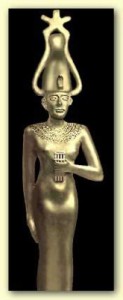The god Sah and his consort, Sopdet, who is probably better known by her Greek name, Sothis, personified the constellation of Orion, which he is sometimes referred to, and the bright, first magnitude star Sirius respectively. Orion was, to the ancient Egyptians, the most distinctive of all the constellations in the night sky, and it rose directly before the adjacent star Sirius, thus explaining the connection between these two ancient gods from a very early date. Orion was imagined as being swallowed at dawn by the Underworld but had the power to emerge again into the night sky. Their son was Soped (Sopdu, Horus Spd), who was another astral deity. They came to be viewed as manifestations of Osiris and Isis.
 Sah, while perhaps not as familiar to us as Sopdet, is mentioned very frequently in the Pyramid Texts, where he is called “father of the gods”. The deceased king is said to enter the sky “In the name of the Dweller in Orion, with a season in the sky and a season on earth”. The association between Sah and Sopdet is also clear in these early texts where the king is told, “You shall reach the sky as Orion, your soul shall be as effective as Sothis”. During the New Kingdom, Funerary texts explains that Orion is said to row towards the stars in a boat and Sah was sometimes depicted in this manner in scenes found in temples and tombs, where he is surrounded by stars as he sails across the sky in a papyrus skiff.
Sah, while perhaps not as familiar to us as Sopdet, is mentioned very frequently in the Pyramid Texts, where he is called “father of the gods”. The deceased king is said to enter the sky “In the name of the Dweller in Orion, with a season in the sky and a season on earth”. The association between Sah and Sopdet is also clear in these early texts where the king is told, “You shall reach the sky as Orion, your soul shall be as effective as Sothis”. During the New Kingdom, Funerary texts explains that Orion is said to row towards the stars in a boat and Sah was sometimes depicted in this manner in scenes found in temples and tombs, where he is surrounded by stars as he sails across the sky in a papyrus skiff.
The reason that Sopdet, or Sothis, is better known to us is that Sirius was, for the ancient Egyptians, a very important star that signaled after having been hidden from view for seventy days, in its appearance on the eastern horizon at dawn during July (Heliacal rising), the coming annual inundation of the Nile River which marked the beginning of the agricultural year. Hence, the goddess was called the “bringer of the New Year and the Nile flood”. It was for this reason that she was associated with Sah, and thus Osiris, who symbolized this annual resurgence of the Nile. In fact, Pyramid Text 965 describes Sopdet as the daughter of Osiris. Therefore, Sopdet became associated with the prosperity resulting from the fertile silt left by the receding waters. In the pyramid text, Sopdet is described as having united with the king-Osiris to give birth to the morning star, Venus, and through her association with that netherworld god, she was naturally identified with Isis, who she was eventually synchronized with as Isis-Sothis. In the Lamentations of Isis and Nephthys, from a fourth century BC papyrus, Isis asserts that she is Sothis, who will unswervingly follow Osiris in his manifestation as Orion in heaven. Though at first an important deity of the inundation and as an afterlife guide to the deceased king through the Field of Rushes, by the Middle Kingdom she was identified as a “mother” and “nurse”.
The earliest known depictions of Sothis, known from a 1st Dynasty ivory tablet belonging to Djer and unearthed at Abydos, represent the goddess as a reclining cow with a plant-like emblem, perhaps representing the “year”, between her horns. She is almost always shown as a woman wearing a tall crown similar to the White Crown of Upper Egypt but with tall, upswept horns at the sides and surmounted by a star with five points. In this iconography, she had few variations, and is usually represented as simply standing with arms at her sides or with one arm folded across her lower breast. However, occasionally the goddess could also be depicted as a large dog. In her syncretistic role as Isis-Sothis, she is also shown riding side-saddle on this symbolic animal on some of the coins minted at Alexandria during Roman times.
The star Sirius may have been worshipped as a cow-goddess in the Predynastic Period before its eventual identification with Isis and Sopdet. Sopdet was clearly an important god in her own right at first, but her growing identification with Isis eventually meant that her individual identity was decreased during later times. By the Graeco-Roman Period, her assimilation with Isis was almost complete. Though we know nothing of any specific cult that worshipped specifically Sopdet, during the excavation for the Cairo Metro (subway), a temple was unearthed that was apparently dedicated to Isis-Sothis.